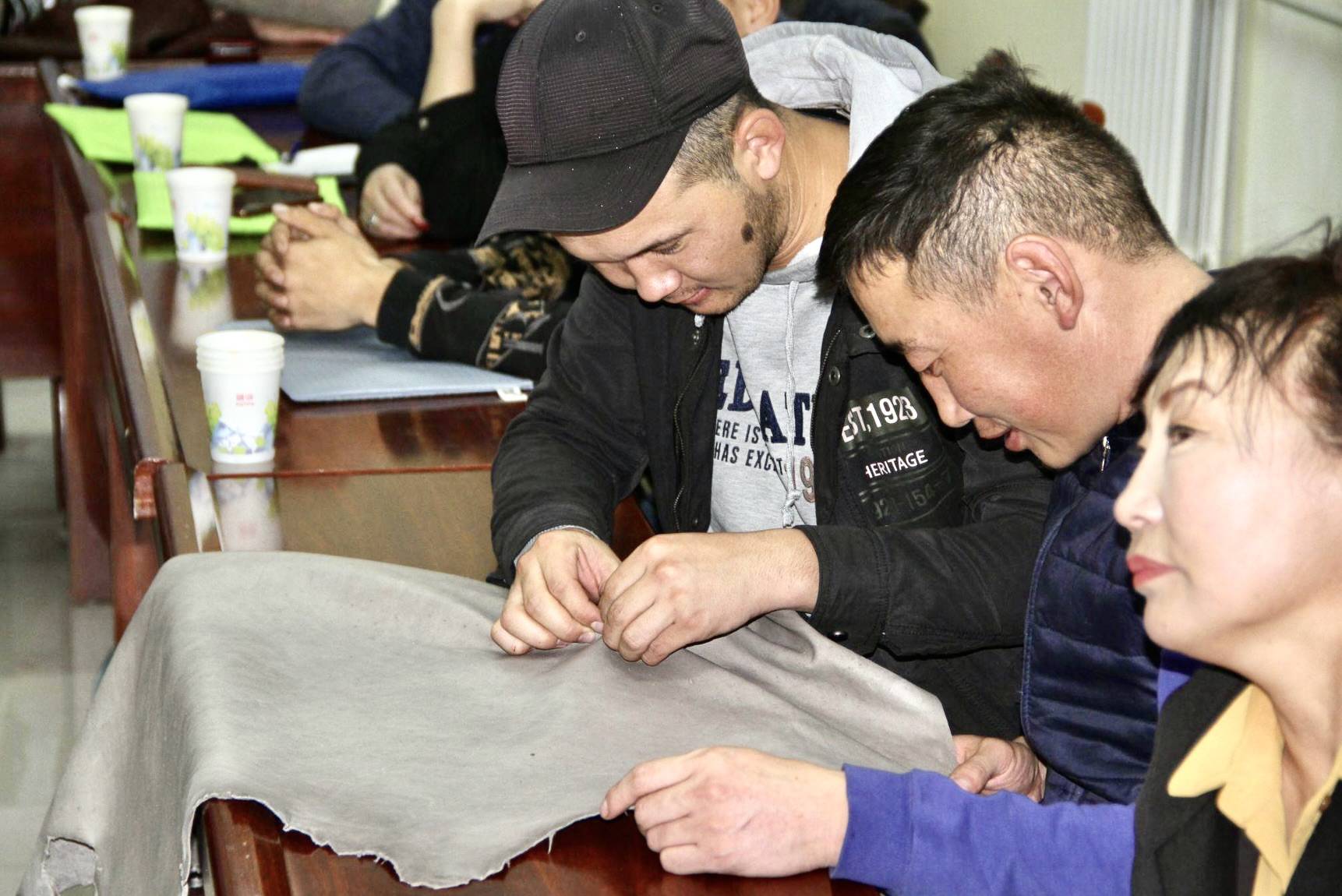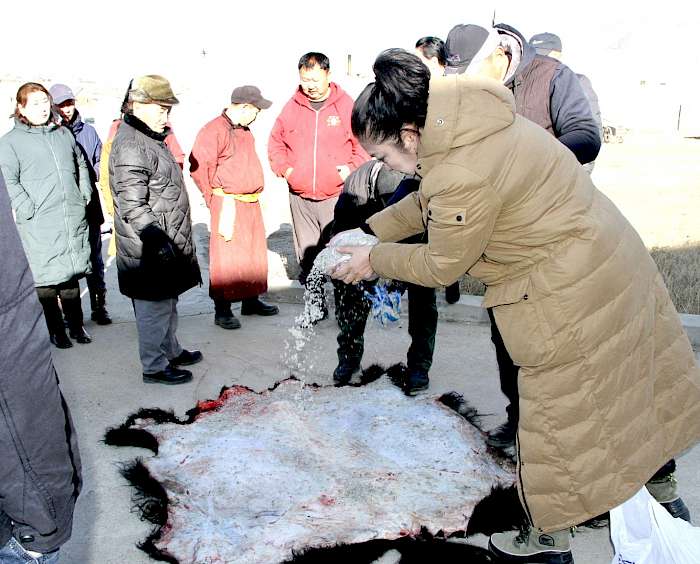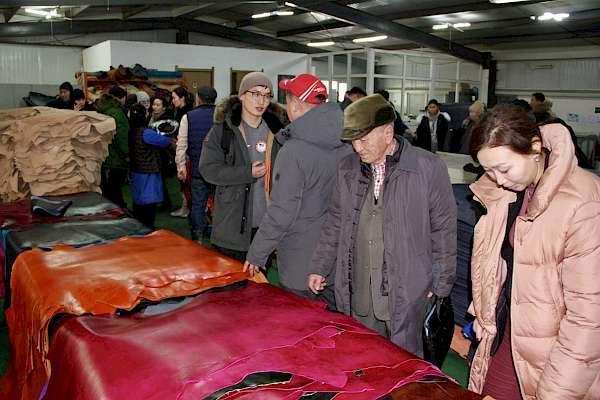
Context
The tanning industry is one of the most important industries in Mongolia even though it is still based on traditional practices, old facilities, equipment and technicalities, and there is a need for increased attention to environmentally-friendly, green technologies and circularity of products. Most factories only process up to the wet blue stage and about 20% produce processed leather. However, this percentage is decreasing due to quality issues linked to resilience, odor and skin damage (World Bank 2019. Mongolia Central Economic Corridor Assessment, A Value Chain Analysis of the Cashmere-Wool, Meat and Leather Industries).
Among the 10.4 million largest animals of Mongolia’s domestic livestock, yaks amount to 1 million and all but 5% are located in six provinces. Yaks are especially suited to the Mongolian context, providing a range of products such as milk, fibres, cashmere, hair, meat and hides, with less disadvantages compared to other cattle (environmental impact of goats, ‘high maintenance’ of cattle) and supporting the livelihood of many households in the yak raising provinces.


The most important use for hides and skins has been the manufacture of leather, used to produce footwear, garments and other goods. Nowadays, the manufacture of leather is dominated by mineral (chrome) tanning, which, along with associated finishing procedures based on synthetics, is very demanding in terms of requirements for energy and water, and polluting in terms of wastes that are generated and effluent discharges.
Vegetable tanning and the manufacture of full grain vegetable leathers present a number of opportunities for reducing inputs and outputs, and thereby contributing to greener and environmentally friendly production.
To respond to the challenges and constraints of the yak leather sector in Mongolia, including: antiquated technology for processing leather; products not complying with international quality standards; outdated infrastructure for treatment of waste; lack of skilled human resources, the European Union funded SWITCH-Asia Sustainable Yak Leather (SYL) was launched to develop the production of bio-leather and the manufacture of associated bio-leather products by strengthening the capacities of the Mongolian Vegetable Tanned Yak Leather Cluster. The project will also contribute to the achievement of the objectives, priorities, and goals set in the Green Development Policy of Mongolia and its Action Plan, the Trade and Investment Roadmap of Mongolia (2019-2023) and the Mongol Export Program.
The SYL Project in a nutshell
Launched on 27th May 2022 and running until 2025, the SYL Project aims to:
-
Establish sustainable and traceable supplies of hides of domesticated yaks, available as raw materials for the emerging, vegetable tanning industry;
- Reduce losses associated with existing (incomplete) collection of hides, and waste attributed to remediation and improper processing;
- Improve the efficiency and effectiveness of tanning, finishing, and leather products manufacturing operations;
- Introduce traceability systems to support the marketing of the Mongolian Vegetable Tanned Yak Leather Cluster’s products abroad, satisfying consumer demand for ethically produced materials and goods.
Within the SYL Project activities:
- Producers and exporters of leather products will be introduced to the developing demands of consumers, and the legal requirements related to labelling and trading of goods nationally and internationally;
- Product manufacturers will be trained in use of CAD/CAM for design and construction, including computer-based systems for identifying (and providing feedback on) defects in raw materials;
- Process control and traceability systems will be established in companies, detailing sources of materials, processing and end users. The systems will provide for input of results of laboratory analyses (checking for residues of pesticides and other prohibited materials, for example) to confirm adherence to acceptable (national and international) standards;
- Tannery staff will be introduced to the importance of all aspects of the quality of raw material (including absence of residues, acceptable preservation methods and the salvaging of residual fat and flesh (for by-products processing) prior to the start of tanning proper;
- Tanners will be introduced to the latest beamhouse (soaking, liming and bating) techniques; based on new selections of chemicals and equipment. This will be accompanied by use of enhanced process monitoring and control techniques - using up to date analysis and testing methods, certified via an approved laboratory – to determine the presence of residues of pesticides for example;
- New, low energy and low emission finishing operations – ambient temperatures, organic dyes and reduced use of synthetic binding agents – will be introduced; increasing the scope for recycling tannery products (and the by-products of tannery operations);
- The new operations will be complemented by development of effluent treatment systems, providing higher levels of reclamation of materials and increased opportunities to recycle water and heat.
Building the capacities of yak value chain stakeholders
From 14th November – 9th December 2022, three 5-days training programmes took place in the four provinces that account for 81% of the country’s resources of yak, namely, Arkhangai, Bayankhongor, Khuvsgul and Uvurkhangai. Among the participants, 25 representatives of the following target groups joined the trainings:
- Herders and veterinary extension officers;
- Traders and merchants engaged in the production and supply of yak hides;
- Staff of slaughter facilities.
The training for herders and veterinary extension officers highlighted essential issues for attention during the life of the animal, and ultimately during slaughter, such as good nutrition, animal health care, attention to animal welfare, use of veterinary services to avoid (or mitigate) significant skin diseases (and associated defects).


 The training for traders and merchants engaged in the production and supply of yak hides, focused on hides’ preservation and storage, with emphasis on features of fresh and preserved hides, environmental issues related to hides for leather, traceability of hides and identification and registration (I&R), sorting, grading, storage and transportation of hides.
The training for traders and merchants engaged in the production and supply of yak hides, focused on hides’ preservation and storage, with emphasis on features of fresh and preserved hides, environmental issues related to hides for leather, traceability of hides and identification and registration (I&R), sorting, grading, storage and transportation of hides.



The training for staff of slaughter facilities focused on flaying and fleshing techniques, with emphasis on ante-mortem inspection of animals, animal welfare, OSH and slaughtering in approved facilities; flaying, fleshing and trimming with appropriate equipment, preservation, chilling, freezing, salting and/or drying.



All three trainings also described the requirements of national legislation (concerning slaughter practices) and standards regarding the production and sorting/grading of hides with special attention to the needs of the users of yak hides, members of the Cluster.
From 9th January - 13th January 2023 a training programme on all aspects of quality of raw material (including absence of residues, acceptable preservation methods and the salvaging of residual fat and flesh (for by-products processing) was delivered, based on the EU partners expertise and international best practices. A cadre of 31 staff of tanneries members of the Mongolian Vegetable Tanned Yak Leather Cluster joined the 5-days training. Individuals were selected on the basis of their responsibilities for inputs to raw materials procurement and processing/production; and included buyers (and/or agents), beamhouse supervisors, and quality assurance technicians. Topics included:
- National legislation and standards related to the production and trade of hides and skins in general (and yak hides in particular);
- Peculiarities of hides production in Mongolia;
- Quality characteristics requirements for hides of tanning, finishing and marketing departments;
- Demands of markets internationally, among others.

The training addressed the determination of quality (in terms of sorts/types of material and grading) of existing supplies of hides and the scope for improvements, using objective and subjective methods. It also demonstrated improvements (to pre-slaughter and peri-slaughter operations) to be adopted by producers supplying raw materials to the tanneries in the future; including (for example) improved fleshing. The adoption of these improvements will help reduce the environmental impact of the Mongolian vegetable tanned yak leather Cluster by decreasing the amount of waste generated (less spoiled hides, utilisation of waste for by-product production). Buyers (and/or agents), beamhouse supervisors and quality assurance technicians were advised on how to maintain information on the quantity and quality of raw materials. Improved processes were also introduced in tanneries to increase compliance with quality assurance requirements. The contents of this training were also linked to (and consistent with) the previous training delivered to herders, veterinary extension officers, traders and merchants of yak hides, and staff of slaughter facilities.




What's next?
From 24th April - 29th April 2023 the project team will provide technical support/advice to the tanneries in the form of a 6-day mission in Ulaanbaatar. Supported by laboratory scale, experimental drums for beamhouse operations, the tanneries will be advised on how to introduce the latest techniques based on new selections of chemicals and equipment. Also, practical (physical) improvements such as segregating raw material into batches of similar type/size material will be introduced to improve consistence of subsequent processing operations.
The project team will also provide technical advice and guidance for the introduction of innovations in tanning and finishing techniques (novel sources of vegetable tannins, low temperature organic dyes). The new procedures introduced in beamhouse operations must be compatible with tanning and finishing, and provide for high levels of exhaustion and scope for recycling and/or improved effluent treatment.
These actions will aim to reduce the environmental impact of such operations by implementing physical improvements and using new chemicals/tannins and equipment that allow hair saving, high levels of liquor exhaustion, and enhanced recycling and effluent treatment, while conforming with technical specifications of vegetable tanning.
Based on the EU partners expertise and international best practices, the tanneries will also receive a ‘Best practice guidelines’ document on environmentally friendly beamhouse, tanning and finishing operations for vegetable tanning.
Learn more from the SYL Project Brochure
Photo credits © SWITCH-Asia SYL Project


